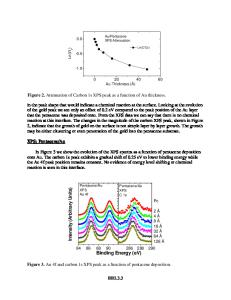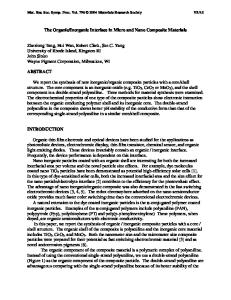Modelling of the Thin Organic Film/Carbon Steel Interface
- PDF / 84,310 Bytes
- 6 Pages / 595 x 842 pts (A4) Page_size
- 81 Downloads / 366 Views
Modelling of the thin organic film/carbon steel interface Mihai V. Popa1, Paula Drob1, Ecaterina Vasilescu1, Maria Anghel1 Iulia Mirza Rosca2, Agustin Santana Lopez2 1 Institute of Physical Chemistry, Spl.Independentei 202, 77208, Bucharest, Romania 2 Las Palmas de Gran Canaria University, Las Palmas, Spain ABSTRACT The electrochemical impedance spectroscopy (EIS) has been used for the modelling of the alkyd organic film/carbon steel interface in 3% NaCl solution. Both the dielectric properties of the organic film and the corrosion processes of the metallic substrate were investigated with this method. Analysis of the impedance spectra (Nyquist and Bode plots) and the interpretation with the fitting software developed by Boukamp, established the presence of two time constants in the first 250 immersion hours. One time constant concerning the organic layer describes the electrical and barrier properties of film. The second time constant concerning the substrate represents the corrosion reactions at the film/metal interface. For long immersion periods, after the formation of the conductive pathways in the film and the development of the diffusion processes, are necessary another two time constants concerning these phenomenons. The error magnitude between the measured and calculated data with these electric equivalent circuits is satisfactory. The physical properties obtained from the principal elements of the equivalent electric circuits are in concordance with those obtained from others testing methods.
INTRODUCTION The organic film/metal interface is quite complex and its corrosion behaviour depends on a large number of different parameters as: the kind of the substrate, the pretreatments of the metallic surface, the film composition, the deposition technique of film, the film thickness, the film adhesion to the metallic substrate. It is important to obtain information about the influence of these parameters on the properties of the organic film/metal interface. These information are very useful for the prediction of the anticorrosive behaviour of the various organic films in service. The electrochemical impedance spectroscopy can provide such information in a short tested time and permits the simulation of the film/metal/electrolyte system with the electrical equivalent circuits [1-6]. Therefore, in last years this technique was widely used with good results for the characterization of the organic films on metallic substrates [7-14]. The application of another new electrochemical technique – the electrochemical noise analysis (ENA) for the same purposes has became of interest [14-19]; the low cost of the equipment and the ease of the data collection seen to be the main attraction of this technique. Kwiatkowski and Bednarkiewicz [20] have monitored the degradation of organic coatings by tensammetry (alternating current voltammetry). This method may be helpful in comparison of the coatings durability in corrosive environments as well as for mechanistic considerations. This paper presents the modelling of the alkyd f
Data Loading...











